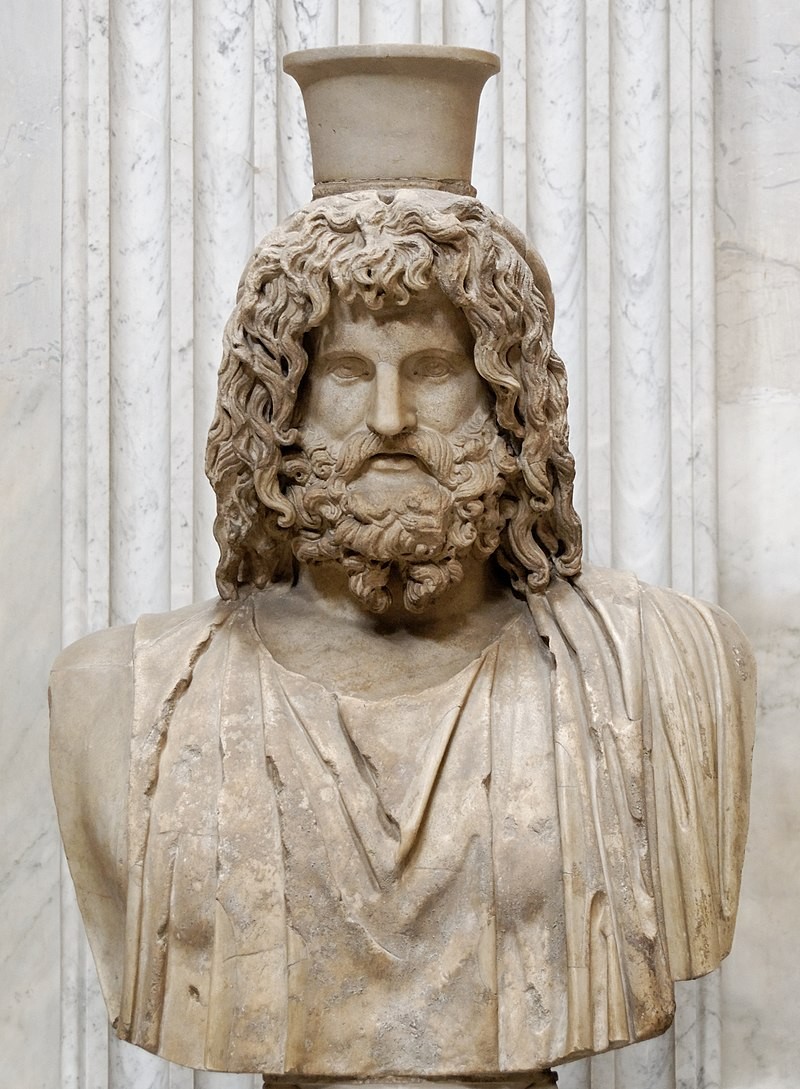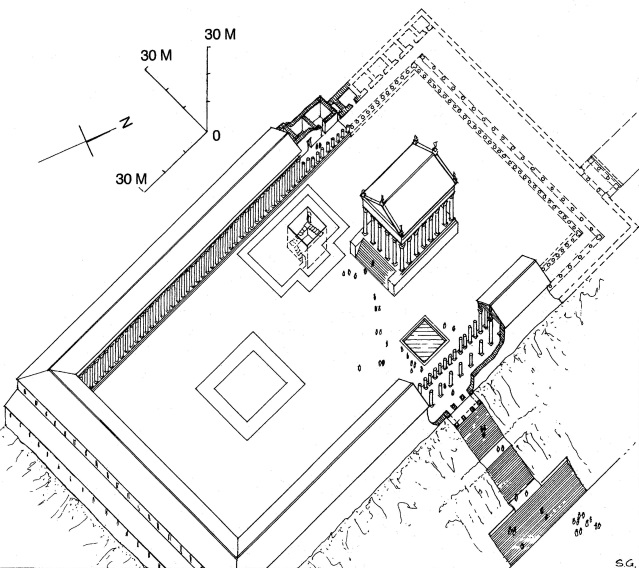The Serapeum of Alexandria: A Fascinating Look at Ancient Egyptian Religion
Imagine walking through the ruins of an ancient temple filled with mystery and wonder. As you step into the Serapeum of Alexandria, you are transported back to the age of ancient Egyptian religion. The Serapeum, dedicated to the god Serapis, was one of the most significant temples in Alexandria during the Greco-Roman period. This fascinating structure held great importance for the people of that time and continues to intrigue historians and archaeologists today. Join us as we delve into the history and significance of the Serapeum of Alexandria.

Introduction to Serapeum of Alexandria
As you delve into the fascinating world of the Serapeum of Alexandria, you'll discover an ancient temple complex shrouded in mystery, religious strife, and architectural wonder. This temple was dedicated to the Greco-Egyptian deity Serapis, an enigmatic figure that merged the features of Osiris and Apis. Ptolemy III built it in the 3rd century BC, and according to contemporary accounts, it was the largest and most impressive temple in Alexandria's Greek quarter - made of marble and adorned with precious items and rare artefacts.
The Serapeum also housed an important library that may have served as an annexe of the Great Library of Alexandria. However, it was the temple's sheer magnificence that captured the attention of visitors throughout the centuries. The temple precinct housed an offshoot collection of the cult of Isis, an image of the god Serapis, and the famous Pompey's Pillar. This red-granite Roman triumphal pillar still stands today and marks the 'Acropolis' of the Serapeum.
Unfortunately, the temple faced a tumultuous end when religious conflict broke out between pagans and Christians. The Serapeum closed in July 325 AD during the persecution of pagans. However, the temple was later destroyed in 391 AD, either by a Christian mob or Roman soldiers, on instructions from the Christian authorities of the Roman Empire. The Serapeum became the final stronghold of pagans, who fortified themselves within the temple complex. But ultimately, it was sacked and destroyed.
Today, little remains of this once-magnificent temple complex, but it still stands as a testament to the architectural achievements of the ancient world. Visitors can access the site and explore the colossal Pompey's Pillar and other artefacts from the temple at the Greco-Roman Museum of Alexandria. Nestled within Alexandria's ancient heart, the Serapeum is just off Karmooz street along the Kanal Al Mahmoudeya Al Bahri road through the city, joining highway 75. It is a 17-minute drive from the international airport and a half-hour walk to Alexandria's train station.
Also, the Serapeum remains an archaeological mystery to this day, with several accounts existing about the context of its destruction. Some historians see its destruction as a victory for Christianity, while others view it as an inevitable outcome of centuries-old conflicts between the Greek and Jewish quarters of the city. Until today, the story of the Serapeum of Alexandria continues to fascinate and intrigue archaeological enthusiasts and historians worldwide. [1][2]

Ptolemaic Dynasty: The Birth of Serapis
The birth of Serapis is closely related to the era of the Ptolemaic dynasty, which saw the fusion of Greek and Egyptian religions. The temple was built honouring the newly invented Serapis deity, a combination of Zeus and Osiris. Built on a hill in the middle of Alexandria, the Serapeum offered a breathtaking view of the city and the Mediterranean Sea. The magnificent temple was culturally and religiously significant, attracting tourists from all over the Mediterranean. The Serapeum was home to a vast library comparable in size and importance to the Library of Alexandria, housing a collection of ancient Egyptian writings, Greek philosophy, and scientific treatises. The temple's architectural design combined Greek and Egyptian elements, further adding charm. As Egypt Travel Guide suggests, some must-visit locations in Egypt are the Giza Pyramids, Saqqara, Philae Temple, Karnak Temple, Memphis, and others.
In the words of Deinocrates, the renowned architect who created the Serapeum, "The temple surpassed all other Greek constructions." Sadly, the temple's glory was short-lived, as it met its untimely end under the orders of Emperor Theodosius I. The temple collapsed under the weight of its massive accumulation of knowledge and treasures, and the remains have remained an archaeological mystery ever since. Even today, the Serapeum remains to continue to fascinate historians and archaeologists from all over the world. According to Wikipedia, the Serapeum was the largest and most impressive temple in the Greek quarter of Alexandria, housing a vast collection of Egyptian mythical objects related to the Osiris myth.
The temple's destruction marked a symbolic victory of Christianity against paganism, as Emperor Theodosius I sought to banish all pagan gods from Alexandria. The Serapeum's ruins symbolised Alexandria's transformation from a centre of learning to the new route of Christianity. Despite the temple's fall, the Serapeum's legacy remains, and its design has even found its way into modern architecture. The Serapeum of Alexandria stands as a testament to the ingenuity of Greek and Egyptian architecture, attracting tourists from all over the world with a thirst for knowledge and deep admiration for ancient cultures. [3][4]

The Temple's Magnificence and Rare Items
As you step into the Serapeum of Alexandria, you will be struck by the magnificence of the temple and the rare items housed within it. The temple was built during the Ptolemaic dynasty, combining Greek and Egyptian gods to create an extraordinary place of worship. It was also a knowledge hub with an extensive library that housed ancient Egyptian writings, Greek philosophy, and scientific treatises. The library at the Serapeum was comparable in size and significance to the Library of Alexandria, and the temple became a well-known pilgrimage destination that drew tourists from all around the Mediterranean.
Archaeologists and historians have always been fascinated by the Serapeum's remains, as they represent a mystery that has yet to be completely unravelled. Despite the temple being a historical and cultural treasure, it was destroyed under the rule of Emperor Theodosius I. Today, visitors can only see the enormous pillar at the site and the rocky plateau that overlooks land and sea. The rest of the temple and its belongings remain shrouded in mystery, which makes it all the more fascinating.
The Serapeum's architecture was a beautiful blend of Greek and Egyptian design elements, and no expense was spared in its construction. It was believed to have been the largest and most magnificent of all temples in the Greek quarter of Alexandria. Besides the image of the god, the temple precinct housed an offshoot collection of the Library of Alexandria. Today's visitors can envision the temple's grandeur through the tall pillar amidst the ruins.
In the words of Herodotus, "Egypt is the gift of the Nile," but the Serapeum of Alexandria is truly the gift of the ancient Egyptians and Greeks. This awe-inspiring temple and its treasures represent a unique fusion of two cultures that greatly influence our world today.
Next, we will explore the archaeological mysteries of the Serapeum remains and uncover the secrets that have captivated researchers for years. Stay tuned for a fascinating journey into the unknown world of one of the most significant temples in history. [5][6]

Archaeological Mysteries of Serapeum Remains
As you explore the Serapeum remains in Alexandria, you will encounter many archaeological mysteries that have puzzled historians and archaeologists for centuries. The temple was famed for its magnificence and rare items, notably the renowned Serapeum library. While it was destroyed under the rule of Emperor Theodosius I, the Serapeum remains a treasure trove for those seeking to uncover the secrets of the ancient world. The site has been heavily plundered, but scholars have found clues that shed light on the history of this grand temple.
According to detailed accounts, the Serapeum was the largest and most magnificent of all temples in the Greek quarter of Alexandria. Besides the image of the god, the temple precinct housed an offshoot collection of the Library of Alexandria. The architecture combined Greek and Egyptian design elements, attracting tourists even more. But what happened to cause its destruction? There are many theories, but the most widely accepted one is that it was closed in July of 325 AD, likely on the orders of the Christian emperor Constantine. This set the stage for riots in Alexandria in 391; when Christians stormed the sanctuary, the pagans were driven out, their temple sacked, and its contents destroyed.
While the destruction may have been the most spectacular of such conflicts, it was not the only one. The city had frequent mob violence, where the Greek and Jewish quarters had fought since the 1st century BC. It is also important to note that non-Christians had participated in citywide struggles for and against Christianity.
Despite the destruction, there are still many things to see and appreciate in the remains of the Serapeum. The enormous Pillar marks the Acropolis of the Serapeum, and even though the temple has been destroyed, the site still has a significant presence. The rocky plateau overlooking the land and sea offers a picturesque vista over Alexandria. Once known for its religious significance and cultural life, the site has become an archaeological treasure that has fascinated scholars and visitors worldwide.
As you delve deeper into the mysteries surrounding the Serapeum remains, you will gain a newfound appreciation for the religious and cultural significance of the site. The destruction of the Serapeum may have marked the triumph of Christianity over paganism, but it also reflects the long-term backdrop of frequent mob violence in the city. Despite its turbulent history, the remains of the Serapeum offer a fascinating look into the ancient world that is not to be missed. [7][8]

Architectural Marvel: Greek and Egyptian Designs
Now that we have explored the history and significance of the Serapeum of Alexandria let's take a closer look at its architectural marvel. The temple is a perfect marriage between Greek and Egyptian designs, which makes it stand out from other Egyptian temples. The Greek influence was evident in the intricate carvings on the walls, the columns, and the pediments, while the Egyptian style was reflected in the overall structure of the temple.
According to historical accounts, the Serapeum was the largest and most magnificent of all temples in the Greek quarter of Alexandria. It was built on a rocky plateau with a breathtaking view overlooking the land and sea. Besides the image of the god, the temple precinct housed an offshoot collection of the Library of Alexandria. Unfortunately, due to heavy plundering, nothing remains above ground except for the enormous Serapeum.
As for the conflict between pagans and Christians, history tells us that the Serapeum was the last stronghold of the pagans, who fortified themselves in the temple and its enclosure. The Christians stormed the sanctuary, the pagans were driven out, the temple was sacked, and its contents were destroyed. The Serapeum was destroyed by Roman soldiers in 391 and was not rebuilt.
After the destruction, a Coptic Orthodox church was established on the site, known as Abu Sefein Church. However, the church collapsed around 600 AD and was finally destroyed in the 10th century. In the 20th century, a Muslim cemetery Bāb Sidra was located at the site.
If you plan to visit Egypt, the Serapeum of Alexandria is a must-see. As a unique blend of two cultures, it is a testament to the richness and diversity of ancient Egyptian religion. And if you plan on organizing a tailor-made tour of Egypt, there are some important things to consider. Firstly, establish your spending limit, choose your preferred travel style, and decide when you will be travelling. Secondly, choose your destinations wisely, as Egypt is a large country with lots to see. Lastly, research and book activities and tours with reputable companies to find the best options for your trip. [9][10]
